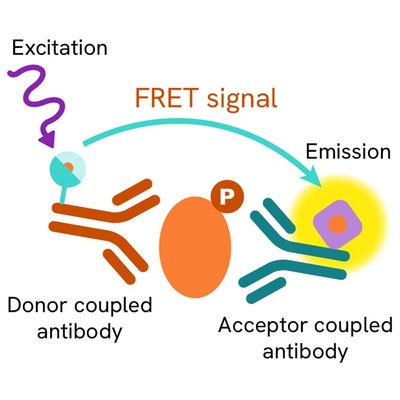

HTRF Human Phospho-EGFR (Pan-Tyr) Detection Kit, 500 Assay Points








| Feature | Specification |
|---|---|
| Application | Cell Signaling |
| Sample Volume | 16 µL |









Product information
Overview
The pan-phospho-EGFR assay is designed for the cell-based quantitative detection of all tyrosine phosphorylations on EGFR. Mutations that lead to an overexpression or hyperactivity of EGFR, also known as ErbB1 or HER1, are associated with a number of cancers, such as lung, colorectal, prostate, glioblastoma cancer, etc. This makes EGFR a key target for anti-cancer therapy-related immunoassay.
How it works
Phospho-EGFR (pan) assay principle
The Phospho-EGFR (pan) assay measures EGFR when phosphorylated at pan. Contrary to Western Blot, the assay is entirely plate-based and does not require gels, electrophoresis or transfer. The Phospho-EGFR (pan) assay uses 2 labeled antibodies: one with a donor fluorophore, the other one with an acceptor. The first antibody is selected for its specific binding to the phosphorylated motif on the protein, the second for its ability to recognize the protein independent of its phosphorylation state. Protein phosphorylation enables an immune-complex formation involving both labeled antibodies and which brings the donor fluorophore into close proximity to the acceptor, thereby generating a FRET signal. Its intensity is directly proportional to the concentration of phosphorylated protein present in the sample, and provides a means of assessing the proteins phosphorylation state under a no-wash assay format.

Phospho-EGFR (pan) 2-plate assay protocol
The 2 plate protocol involves culturing cells in a 96-well plate before lysis then transferring lysates to a 384-well low volume detection plate before adding Pan Phospho-EGFR HTRF detection reagents. This protocol enables the cells' viability and confluence to be monitored.

Phospho-EGFR (pan) 1-plate assay protocol
Detection of Phosphorylated Pan EGFR with HTRF reagents can be performed in a single plate used for culturing, stimulation and lysis. No washing steps are required. This HTS designed protocol enables miniaturization while maintaining robust HTRF quality.

Assay validation
EGF dose-response on A431 cells
Human A431 cells (5,000 cells/well) were stimulated for 30 min at 37°C with various concentrations of EGF. After a 30 min lysis incubation time, phosphorylated EGFR was measured using the one-plate assay protocol of the pan-EGFR assay.

Inhibition of EGFR phosphorylation
Cells were plated in 96-well plate and incubated for 24h. After a pre-treatment with a dose-response of inhibitors, the cells were stimulated with EGF. Following cell lysis, lysates were transferred into a 384-sv white microplate for detection and HTRF phospho-EGFR detection reagents were added. HTRF signal was recorded after an overnight incubation. Results show the applicability of the HTRF phospho-EGFR assay to decipher the mechanism of action of small molecules and biologics targeting EGFR.

Inhibition of EGFR phosphorylation
Cells were pre-treated with a dose-response of Erlotinib and Lapatinib, 2 small Tyrosine Kinase inhibitors. compound. A control was done using PQ401, a non-inhibitor compound (Figure 1 on the left). Cells were pre-treated with a dose-response of Cetuximab, a therapeutic monoclonal antibody. A control was done using a non-inhibitor MAb control (15441) (Figure 2 on the right).


Simplified pathway
EGFR Epidermal growth factor receptor signaling Simplified Pathway
EGFR is a receptor tyrosine kinase that belongs to the ErbB family. Binding of EGFR ligands drive receptor homodimerization or hetero-dimerization leading to the activation of the EGFR tyrosine kinase domain and specific tyrosine residues. The phosphorylated tyrosine residues then provide docking sites for a variety of factors that induce downstream activation of several signal transduction cascades. The transmitted signals from the EGF receptor to the nucleus lead to the regulation of various biological functions such as cell proliferation, differentiation, survival, adhesion, migration & angiogenesis. Mutations that lead to overexpression or hyperactivity of EGFR are associated with a number of cancers making EGFR a key target for anti-cancer therapies.

Specifications
| Application |
Cell Signaling
|
|---|---|
| Brand |
HTRF
|
| Detection Modality |
HTRF
|
| Lysis Buffer Compatibility |
Lysis Buffer 3
Lysis Buffer 4
Lysis Buffer 5
|
| Molecular Modification |
Phosphorylation
|
| Product Group |
Kit
|
| Sample Volume |
16 µL
|
| Shipping Conditions |
Shipped in Dry Ice
|
| Target Class |
Phosphoproteins
|
| Target Species |
Human
|
| Technology |
TR-FRET
|
| Therapeutic Area |
Oncology & Inflammation
|
| Unit Size |
500 assay points
|
Video gallery
Resources
Are you looking for resources, click on the resource type to explore further.
Discover the versatility and precision of Homogeneous Time-Resolved Fluorescence (HTRF) technology. Our HTRF portfolio offers a...
This guide provides you an overview of HTRF applications in several therapeutic areas.


Loading...
How can we help you?
We are here to answer your questions.






























